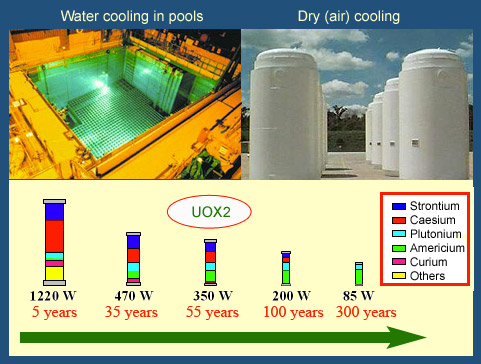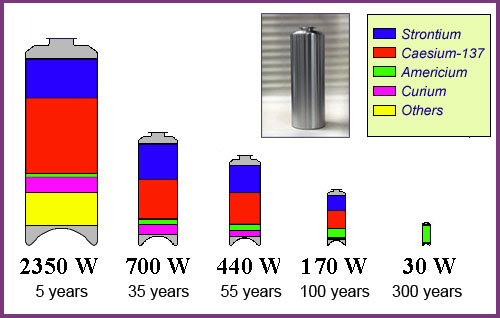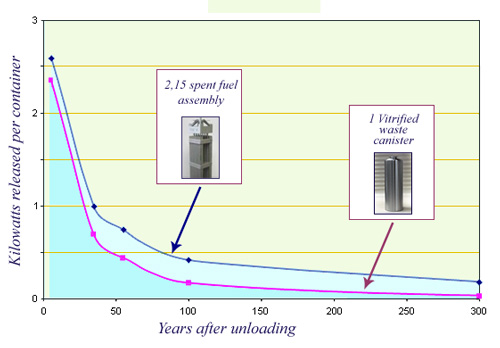Significant, slow-to-decline heat release

Heat released by a spent fuel assembly
A uranium oxide (UOX) fuel assembly weighs approximately 500 kg. Five years after being unloaded from the reactor, it emits heat equivalent to twelve 100 watt light bulbs. This heat release steadily tails off, falling to 85 watts after 300 years. Spent fuel assemblies must be cooled prior to disposal, either in a pool or in dry silos.
© CNE (2004 assessment report)
The heat released by radioactive disintegration is a key consideration in high-level waste management strategies. The heat is generated inside a fuel assembly or vitrified waste package, as these materials absorb most of the emitted radiation.
Like radioactivity and radiotoxicity, the amount of heat released decays over time. Heat release is particularly intense when the fuel has recently been unloaded from the reactor. As a result, in France, irradiated fuel is stored in a pool near the reactor for an initial period, followed by several years in another pool in La Hague before being reprocessed.

Heat released by vitrified waste
Like spent fuel assemblies, vitrified waste packages release heat. The heat output decays faster. A waste package, whith a total volume of approximately 200 litres and containing 150 litres of glass, initially releases 3000 W, tapering to 700 W after 35 years, 170 W after 100 years and less than 30 W after 300 years.
© CNE
Vitrified waste obtained after removing uranium and plutonium from spent fuel emits less heat. It cools more rapidly.
In both cases, however, heat is released constantly. When the time is right to dispose of the fuel assembly or vitrified waste package in a repository, these materials will be surrounded by rock with no cooling or ventilation provision. The host rock will be heated.
To be effective, the waste management strategy must aim to prevent the temperature from reaching 100°C, ensuring that any water present does not evaporate. Accordingly, the most highly radioactive materials are held in storage prior to disposal. They must be allowed to cool sufficiently before moving them to a repository.

Heat release comparison
This chart compares the heat released by the spent fuel and vitrified waste represented in the previous diagrams, assuming that fission products from the spent fuel are present in the vitrified waste. Based on this data, a vitrified waste container is equivalent to 2.15 spent fuel assemblies. Removing the plutonium significantly reduces the heat released, by 30% after 35 years and 60% after 100 years. This decrease would enable smaller disposal facilities to be used.
© IN2P3 : data taken from the 2004 report by the national assessment commission (CNE)
This storage applies to both spent fuel assemblies (in pools or dry storage) and vitrified waste (in ventilated shafts). Waste that is thoroughly cooled can be disposed of in smaller depositories.<
Other articles on the subject « Spent nuclear fuel »
Reactor unloading
Fuel unloading and initial pool storage of spent fuel The fuel load in a conventional pressurised[...]
Spent fuel Burn-up
Irradiation rate and energy supplied by fuel The energy produced by a nuclear power plant is prop[...]
Spent fuel composition
Key figures on spent fuel composition The composition of irradiated fuel removed from a reactor c[...]
Waste radioactivity decrease
A natural but slow decay process As natural radioactivity progressively decays, the radioactivity[...]
Spent fuel radiotoxicity
A risk indicator more pessimistic than radioactive activity Radioactivity is an imperfect descrip[...]